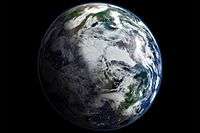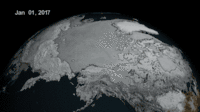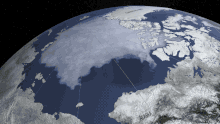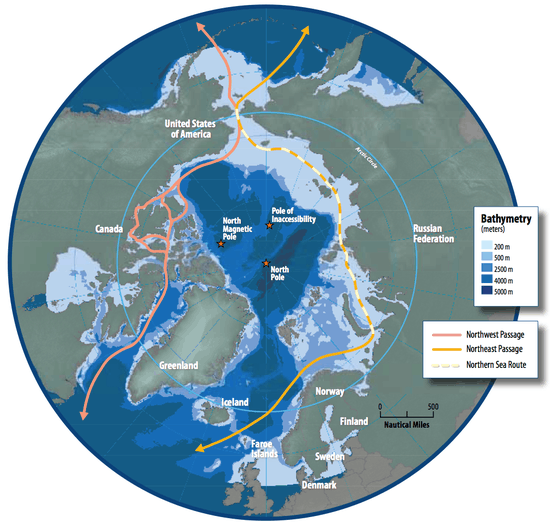Arctic sea ice decline




Arctic sea ice decline is the sea ice loss observed in recent decades in the Arctic Ocean. The Intergovernmental Panel on Climate Change (IPCC) Fourth Assessment Report states that greenhouse gas forcing is largely, but not wholly, responsible for the decline in Arctic sea ice extent. A study from 2011 suggested that internal variability enhanced the greenhouse gas forced sea ice decline over the last decades.[1] A study from 2007 found the decline to be "faster than forecasted" by model simulations.[2] The IPCC Fifth Assessment Report concluded with high confidence that sea ice continues to decrease in extent, and that there is robust evidence for the downward trend in Arctic summer sea ice extent since 1979.[3] It has been established that the region is at its warmest for at least 40,000 years and the Arctic-wide melt season has lengthened at a rate of 5 days per decade (from 1979 to 2013), dominated by a later autumn freezeup.[4] Sea ice changes have been identified as a mechanism for polar amplification.[5]
Definitions
The Arctic Ocean is the mass of water positioned approximately above latitude 65° N. Arctic Sea Ice refers to the area of the Arctic Ocean covered in ice. The Arctic sea ice minimum is the day in a given year when Arctic sea ice reaches its smallest extent. It occurs at the end of the summer melting season, normally during September. Arctic Sea ice maximum is the day of a year when Arctic sea ice reaches its largest extent near the end of the Arctic cold season, normally during March.[6] Typical data visualizations for Arctic sea ice include average monthly measurements or graphs for the annual minimum or maximum extent, as shown in the adjacent images.
Observation
An article in Popular Mechanics, published in March 1912, described open waters in the Arctic regions in 1911, a year with exceptional above average temperatures.[7]
Satellite era

Observation with satellites show that Arctic sea ice area, extent, and volume have been in decline for a few decades. Sometime during the 21st century, sea ice may effectively cease to exist during the summer. Sea ice extent is defined as the area with at least 15% ice cover.[8] The amount of multi-year sea ice in the Arctic has declined considerably in recent decades. In 1988, ice that was at least 4 years old accounted for 26% of the Arctic's sea ice. By 2013, ice that age was only 7% of all Arctic sea ice.[9]
Scientists recently measured sixteen-foot (five-meter) wave heights during a storm in the Beaufort Sea in mid-August until late October 2012. This is a new phenomenon for the region, since a permanent sea ice cover normally prevents wave formation. Wave action breaks up sea ice, and thus could become a feedback mechanism, driving sea ice decline.[10]
For January 2016, the satellite based data showed the lowest overall Arctic sea ice extent of any January since records begun in 1979. Bob Henson from Wunderground noted:
Hand in hand with the skimpy ice cover, temperatures across the Arctic have been extraordinarily warm for midwinter. Just before New Year’s, a slug of mild air pushed temperatures above freezing to within 200 miles of the North Pole. That warm pulse quickly dissipated, but it was followed by a series of intense North Atlantic cyclones that sent very mild air poleward, in tandem with a strongly negative Arctic oscillation during the first three weeks of the month.[11]
The January 2016's remarkable phase transition of Arctic oscillation was driven by a rapid tropospheric warming in the Arctic, a pattern that appears to have increased surpassing the so-called stratospheric sudden warming.[12] The previous record of the lowest area of the Arctic Ocean covered by ice in 2012 saw a low of 1.58 million square miles (4.1 million square kilometers). This replaced the previous record set on September 28, 2007 at 1.61 million square miles(4.17 million square kilometers).[13]
Ice-free summer
.jpg)

An "ice-free" Arctic Ocean is often defined as "having less than 1 million square kilometers of sea ice", because it is very difficult to melt the thick ice around the Canadian Arctic Archipelago.[15][16][17] The IPCC AR5 defines "nearly ice-free conditions" as sea ice extent less than 106 km2 for at least five consecutive years.[3]
Many scientists have attempted to estimate when the Arctic will be "ice-free". Professor Peter Wadhams of the University of Cambridge is among these scientists.[18] Wadhams and several others have noted that climate model predictions have been overly conservative regarding sea ice decline.[2][19] A 2013 paper suggested that models commonly underestimate the solar radiation absorption characteristics of wildfire soot.[20] A 2006 paper predicted "near ice-free September conditions by 2040".[21]Overland and Wang (2013) investigated three different ways of predicting future sea ice levels. From sea ice models and recent satellite images it can be expected that a sea ice free summer will come before 2020.[22] The IPCC AR5 (for at least one scenario) estimates an ice-free summer might occur around 2050.[3] The Third U.S. National Climate Assessment (NCA), released May 6, 2014, reports that the Arctic Ocean is expected to be ice free in summer before mid-century. Models that best match historical trends project a nearly ice-free Arctic in the summer by the 2030s.[23] However, these models do tend to underestimate the rate of sea ice loss since 2007. Based on the outcomes of several different models, Overland and Wang (2013) put the early limit for a sea ice free summer Arctic near 2040.[22]

Warming Arctic temperatures provide a powerful forcing toward lessened sea ice coverage[24]
Tipping point
There is an ongoing debate if the Arctic Ocean has already passed a "tipping point", defined as a threshold for abrupt and irreversible change. A 2013 study identified an abrupt transition to increased seasonal ice cover variability in 2007, which has persisted in following years. The researchers made a distinction between a bifurcation and a non-bifurcation `tipping point'.[25] The IPCC AR5 report stated with medium confidence that precise levels of climate change sufficient to trigger a tipping point remain uncertain, and that the risk associated with crossing multiple tipping points increases with rising temperature.[26]
Implications

Physical implications which arise from lesser ocean surface covered sea-ice include the ice-albedo feedback or warmer sea surface temperatures which increase ocean heat content. As Peter Wadhams, a polar researcher writes "once summer ice yields to open water, the albedo... drops from 0.6 to 0.1, which will further accelerate warming of the Arctic and of the whole planet"[27] This in turn changes evaporation patterns and the polar vortex. Economical implications of ice free summers and the decline in Arctic ice volumes include a greater number of journeys across the Arctic Ocean Shipping lanes during the year. This number has grown from 0, in 1979 to 400–500 along the Bering strait and >40 along the Northern Sea Route, in 2013.[28]
Atmospheric chemistry
Melting of sea ice releases molecular chlorine, which reacts with sunlight to produce chlorine atoms. Because chlorine atoms are highly reactive, they can expedite the degradation of methane and tropospheric ozone and the oxidation of mercury to more toxic forms.[29] Cracks in sea ice are causing ozone and mercury uptake in the surrounding environment.[30]
A 2015 study concluded that Arctic sea ice decline accelerates methane emissions from the Arctic tundra. One of the study researchers noted, "The expectation is that with further sea ice decline, temperatures in the Arctic will continue to rise, and so will methane emissions from northern wetlands."[31]
Atmospheric regime
A link has been proposed between reduced Barents-Kara sea ice and cold winter extremes over northern continents.[32] Model simulation suggest diminished Arctic sea ice may have been a contributing driver of recent wet summers over northern Europe, because of a weakened jet stream, which dives further south.[33] Extreme summer weather in northern mid-latitudes has been linked to a vanishing cryosphere.[34] Evidence suggest that the continued loss of Arctic sea-ice and snow cover may influence weather at lower latitudes. Correlations have been identified between high-latitude cryosphere changes, hemispheric wind patterns and mid-latitude extreme weather events for the Northern Hemisphere.[35] A study from 2004, connected the disappearing sea ice with a reduction of available water in the American west.[36]
Based on effects of Arctic amplification (warming) and ice loss, a study in 2015 concluded that highly amplified jet-stream patterns are occurring more frequently in the past two decades, and that such patterns can not be tied to certain seasons. Additionally it was found that these jet-stream patterns often lead to persistent weather patterns that result in extreme weather events. Hence, continued heat trapping emissions favour increased formation of extreme events caused by prolonged weather conditions.[37]
Plant and animal life
Sea ice decline has been linked to boreal forest decline in North America and is assumed to culminate with an intensifying wildfire regime in this region.[38] The annual net primary production of the Eastern Bering Sea was enhanced by 40–50% through phytoplankton blooms during warm years of early sea ice retreat.[39]
Polar bears are turning to alternate food sources because Arctic sea ice melts earlier and freezes later each year. As a result, they have less time to hunt their historically preferred prey of seal pups, and must spend more time on land and hunt other animals.[40] As a result, the diet is less nutritional, which leads to reduced body size and reproduction, thus indicating population decline in polar bears.[41]
Shipping
Melting Arctic ice caps are likely to increase traffic through the Arctic Ocean.[42][43] An early study by James Hansen and colleagues suggested in 1981 that warming of 5 to 10 °C, which they expected as the range of Arctic temperature change corresponding to doubled CO2 concentrations, could open the Northwest Passage.[44] A 2016 study concludes that Arctic warming and sea ice decline will lead to "remarkable shifts in trade flows between Asia and Europe, diversion of trade within Europe, heavy shipping traffic in the Arctic and a substantial drop in Suez traffic. Projected shifts in trade also imply substantial pressure on an already threatened Arctic ecosystem."[45] In August 2017, the first ship traversed the Northern Sea Route without the use of ice-breakers.[46] Also in 2017, the Finnish icebreaker MSV Nordica, set a record for the earliest crossing of the Northwest Passage.[47] According to the New York Times, this forebodes more shipping through the Arctic, as the sea ice melts and makes shipping easier.[46] A 2016 report by the Copenhagen Business School found that large-scale trans-Arctic shipping will become economically viable by 2040.[48][46]
See also
References
- ↑ Jennifer E. Kay, Marika M. Holland & Alexandra Jahn (August 22, 2011). "Inter-annual to multi-decadal Arctic sea ice extent trends in a warming world". Geophysical Research Letters. 38. Bibcode:2011GeoRL..3815708K. doi:10.1029/2011GL048008.
- 1 2 Stroeve, J.; Holland, M. M.; Meier, W.; Scambos, T.; Serreze, M. (2007). "Arctic sea ice decline: Faster than forecast". Geophysical Research Letters. 34 (9): L09501. Bibcode:2007GeoRL..3409501S. doi:10.1029/2007GL029703.
- 1 2 3 IPCC AR5 WG1 (2013). "The Physical Science Basis" (PDF).
- ↑ J. C. Stroeve; T. Markus; L. Boisvert; J. Miller; A. Barrett (2014). "Changes in Arctic melt season and implications for sea ice loss". Geophysical Research Letters. 41: 1216–1225. Bibcode:2014GeoRL..41.1216S. doi:10.1002/2013GL058951.
- ↑ Kwang-Yul Kim1, Benjamin D. Hamlington2, Hanna Na3, and Jinju Kim1. "Mechanism of seasonal Arctic sea ice evolution and Arctic amplification". The Cryosphere.
- ↑ NSIDC. "Quick Facts on Arctic Sea Ice". Retrieved 15 May 2015.
- ↑ Francis Molena (1912). "Remarkable Weather of 1911". Popular Mechanics.
- ↑ "Daily Updated Time series of Arctic sea ice area and extent derived from SSMI data provided by NERSC". Archived from the original on 10 September 2013. Retrieved 14 September 2013.
- ↑ Watch 27 years of 'old' Arctic ice melt away in seconds The Guardian 21 February 2014
- ↑ Hannah Hickey (July 29, 2014). "Huge waves measured for first time in Arctic Ocean". University of Washington.
- ↑ "Absurd January Warmth in Arctic Brings Record-Low Sea Ice Extent". Wunderground. 2016.
- ↑ Wang, S.-Y. S., Y.-H. Lin, M.-Y. Lee, J.-H. Yoon, J. D. D. Meyer, and P. J. Rasch (2017), Accelerated increase in the Arctic tropospheric warming events surpassing stratospheric warming events during winter, Geophys. Res. Lett., 44, doi:10.1002/2017GL073012.
- ↑ "Arctic Sea Ice Hits Record Low—Extreme Weather to Come?". 2016-08-29. Retrieved 2016-11-29.
- ↑ "Thermodynamics: Albedo". NSIDC.
- ↑ http://www.pnas.org/content/early/2013/07/10/1219716110.abstract PNAS
- ↑ http://phys.org/news/2013-08-ice-free-arctic-2050s.html#inlRlv
- ↑ http://www.atmos.pku.edu.cn/yhu/pnas-liu-2013.pdf
- ↑ Wadhams, Peter (20 June 2015). "Our time is running out – The Arctic sea ice is going!". www.youtube.com. Retrieved 29 November 2016.
- ↑ Overland, J. E.; Wang, M. (2013). "When will the summer Arctic be nearly sea ice free?". Geophysical Research Letters. 40 (10): 2097. Bibcode:2013GeoRL..40.2097O. doi:10.1002/grl.50316.
- ↑ China, Swarup; Claudio, Mazzoleni; Gorkowski, Kyle; Aiken, Allison; Dubey, Manvendra (2013). "Morphology and mixing state of individual freshly emitted wildfire carbonaceous particles". Nat. Commun. 4. Bibcode:2013NatCo...4E2122C. doi:10.1038/ncomms3122.
- ↑ Holland, M. M.; Bitz, C. M.; Tremblay, B. (2006). "Future abrupt reductions in the summer Arctic sea ice". Geophysical Research Letters. 33 (23). Bibcode:2006GeoRL..3323503H. doi:10.1029/2006GL028024.
- 1 2 Overland, James E. (21 May 2013). "When will the summer Arctic be nearly sea ice free?". Geophysical Research Letters. 40: 2097–2101. Bibcode:2013GeoRL..40.2097O. doi:10.1002/grl.50316.
- ↑ "Melting Ice Key Message Third National Climate Assessment". National Climate Assessment. Retrieved 25 June 2014.
- ↑ Comiso, J.C., Parkinson, C.L., Gersten, R. and Stock, L., 2008. Accelerated decline in the Arctic sea ice. Geophysical research letters, 35(1).
- ↑ Valerie N. Livina, Timothy M. Lenton (2013). "A recent tipping point in the Arctic sea-ice cover: abrupt and persistent increase in the seasonal cycle since 2007". The Cryosphere. 7: 275–286. arXiv:1204.5445. Bibcode:2013TCry....7..275L. doi:10.5194/tc-7-275-2013.
- ↑ IPCC AR5 WGII (2014). "Climate change 2014, Impacts, Adaptation and Vulnerability" (PDF). Archived from the original (PDF) on 2015-05-14.
- ↑ Wadhams, Peter (2016). A Farewell To Ice. UK: Penguin. p. 4. ISBN 9780241009413.
- ↑ Society, National Geographic. "Interactive Map: The Changing Arctic". National Geographic. Retrieved 2016-11-29.
- ↑ Jin Liao et al.(2013) (January 2014). "High levels of molecular chlorine in the Arctic atmosphere". Nature Geoscience. 7: 91–94. Bibcode:2014NatGe...7...91L. doi:10.1038/ngeo2046. Retrieved January 14, 2014.
- ↑ Christopher W. Moore; Daniel Obrist; Alexandra Steffen; Ralf M. Staebler; Thomas A. Douglas; Andreas Richter; Son V. Nghiem (January 2014). "Convective forcing of mercury and ozone in the Arctic boundary layer induced by leads in sea ice". Nature Letters. 506: 81–84. Bibcode:2014Natur.506...81M. doi:10.1038/nature12924. Retrieved January 16, 2014.
- ↑ "Melting Arctic sea ice accelerates methane emissions". ScienceDaily. 2015.
- ↑ Vladimir Petoukhov; Vladimir A. Semenov (November 2010). "A link between reduced Barents-Kara sea ice and cold winter extremes over northern continents". Journal of Geophysical Research: Atmospheres. 115 (21). Bibcode:2010JGRD..11521111P. doi:10.1029/2009JD013568. Retrieved January 26, 2014.
- ↑ J A Screen (November 2013). "Influence of Arctic sea ice on European summer precipitation". Environmental Research Letters. 8 (4): 044015. Bibcode:2013ERL.....8d4015S. doi:10.1088/1748-9326/8/4/044015. Retrieved January 26, 2014.
- ↑ Qiuhong Tang; Xuejun Zhang; Jennifer A. Francis (December 2013). "Extreme summer weather in northern mid-latitudes linked to a vanishing cryosphere". Nature Climate Change. 4: 45–50. Bibcode:2014NatCC...4...45T. doi:10.1038/nclimate2065. Retrieved January 26, 2014.
- ↑ James E. Overland (December 2013). "Atmospheric science: Long-range linkage". Nature Climate Change. 4 (1): 11–12. Bibcode:2014NatCC...4...11O. doi:10.1038/nclimate2079. Retrieved January 26, 2014.
- ↑ Jacob O. Sewall, Lisa Cirbus Sloan (2004). "Disappearing Arctic sea ice reduces available water in the American west". Geophysical Research Letters. 31. Bibcode:2004GeoRL..31.6209S. doi:10.1029/2003GL019133.
- ↑ Jennifer Francis, Natasa Skific (1 June 2015). "Evidence linking rapid Arctic warming to mid-latitude weather patterns". Philosophical Transactions. The Royal Society Publishing. 373: 20140170. Bibcode:2015RSPTA.37340170F. doi:10.1098/rsta.2014.0170. PMC 4455715.
- ↑ Martin P. Girardin; Xiao Jing Guo; Rogier De Jong; Christophe Kinnard; Pierre Bernier; Frédéric Raulier (December 2013). "Unusual forest growth decline in boreal North America covaries with the retreat of Arctic sea ice". Global Change Biology. 20: 851–866. Bibcode:2014GCBio..20..851G. doi:10.1111/gcb.12400. Retrieved January 26, 2014.
- ↑ Zachary W. Brown; Kevin R. Arrigo (January 2013). "Sea ice impacts on spring bloom dynamics and net primary production in the Eastern Bering Sea". Journal of Geophysical Research: Oceans. 118 (1): 43–62. Bibcode:2013JGRC..118...43B. doi:10.1029/2012JC008034. Retrieved January 26, 2014.
- ↑ Elizabeth Peacock; Mitchell K. Taylor; Jeffrey Laake; Ian Stirling (April 2013). "Population ecology of polar bears in Davis Strait, Canada and Greenland". The Journal of Wildlife Management. 77 (3): 463–476. doi:10.1002/jwmg.489. Retrieved January 26, 2014.
- ↑ Karyn D. Rode; Steven C. Amstrup; Eric V. Regehr (2010). "Reduced body size and cub recruitment in polar bears associated with sea ice decline". Ecological Applications. 20: 768–782. doi:10.1890/08-1036.1. Retrieved January 26, 2014.
- ↑ Fountain, Henry (2017-07-23). "With More Ships in the Arctic, Fears of Disaster Rise". The New York Times. ISSN 0362-4331. Retrieved 2017-07-24.
- ↑ McGrath, Matt (2017-08-24). "First tanker crosses northern sea route without ice breaker". BBC News. Retrieved 2017-08-24.
- ↑ Hansen, J.; et al. (1981). "Climate impact of increasing atmospheric carbon dioxide". Science. 231: 957–966. Bibcode:1981Sci...213..957H. doi:10.1126/science.213.4511.957.
- ↑ Bekkers, Eddy; Francois, Joseph F.; Rojas-Romagosa, Hugo (2016-12-01). "Melting Ice Caps and the Economic Impact of Opening the Northern Sea Route". The Economic Journal: n/a–n/a. doi:10.1111/ecoj.12460. ISSN 1468-0297. Archived from the original on 2016-12-20.
- 1 2 3 Goldman, Russell (2017-08-25). "Russian Tanker Completes Arctic Passage Without Aid of Icebreakers". The New York Times. ISSN 0362-4331. Retrieved 2017-08-26.
- ↑ "Ship sets record for earliest crossing of notorious Northwest Passage through Arctic". The Independent. July 30, 2017.
- ↑ "Arctic shipping - Commercial opportunities and challenges" (PDF).
External links
- Third National Climate Assessment | Melting Ice
- NASA Earth Observatory | Arctic Sea Ice
- Wunderground | Arctic Sea Ice Decline
- Piecing together the Arctic’s sea ice history back to 1850
- How predictable is the first ice-free Arctic summer?